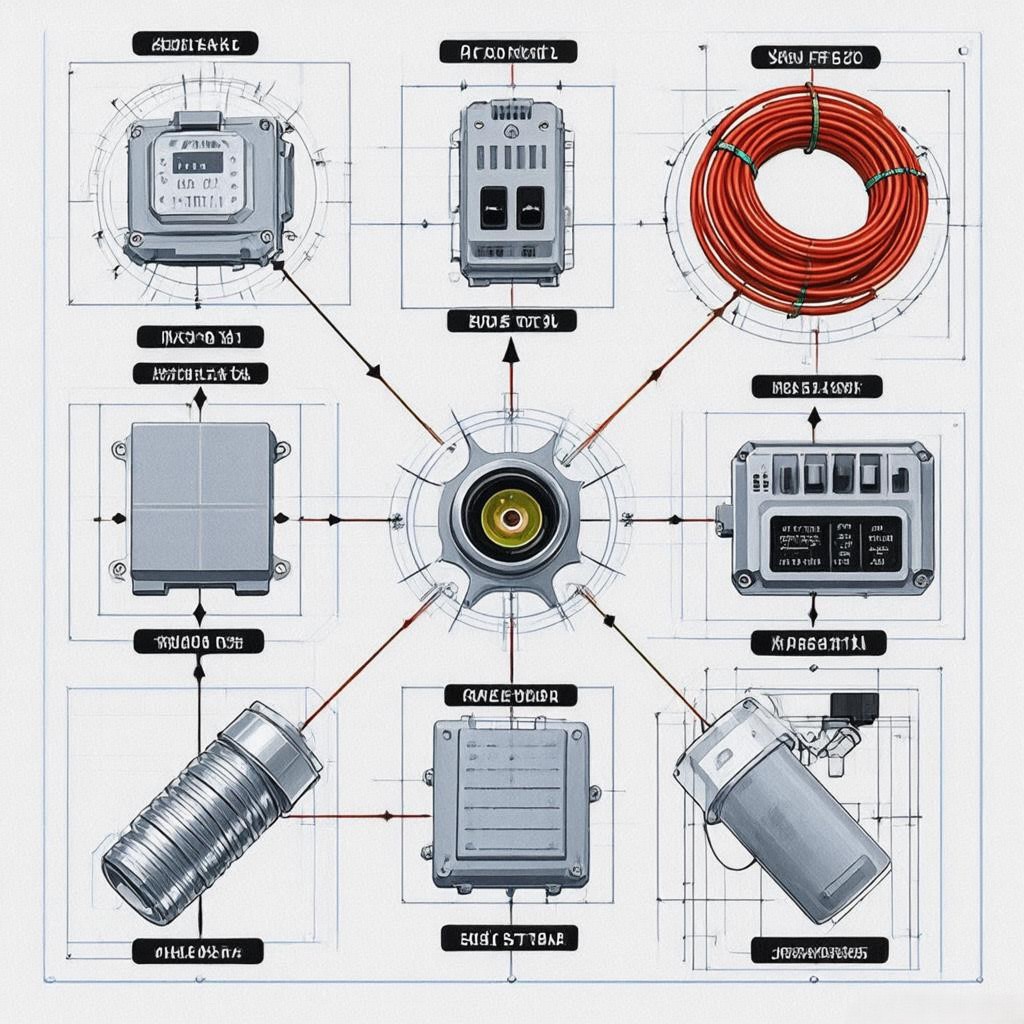Introduction
Modern Anti-Lock Braking Systems (ABS) are critical for maintaining control and stability in heavy-duty trucks, especially under adverse road conditions. However, the reliability of ABS hinges on two often-overlooked factors: sensor-module compatibility and electromagnetic signal integrity. This blog dives deep into the technical challenges of ABS components, strategies for preventing signal interference, and best practices for ensuring seamless integration across diverse truck architectures.
ABS 101: Core Components and Their Roles
1. Wheel Speed Sensors (WSS)
- Function: Detect rotational speed of each wheel via magnetic or Hall-effect principles.
- Key Metrics: Signal frequency (1–5 kHz), air gap tolerance (0.5–2.0 mm), and temperature range (-40°C to +150°C).
- Types: Passive (inductive) vs. active (Hall-effect, requiring external power).
2. ABS Control Module
- Role: Analyzes WSS data to modulate brake pressure via solenoid valves.
- Processing Power: Modern modules (e.g., WABCO EBS3) handle 100+ CAN messages/sec.
3. Solenoid Valves
- Operation: Regulate air pressure to brake chambers at 10–20 Hz frequency.
4. Diagnostic Port
- Protocols: J1939 (heavy-duty), OBD-II (light commercial), or proprietary systems (e.g., Scania SDP3).
Compatibility Testing: Avoiding Costly Mismatches
ABS failures often stem from incompatibilities between sensors, modules, and vehicle electrical systems.
Step 1: Electrical Compatibility Checks
- Voltage Matching: Verify sensor output (0.5–2.5V for active WSS) aligns with module input thresholds.
- Current Draw: Active WSS typically require 7–15 mA; exceeding this can overload legacy modules.
Step 2: Protocol Validation
- Signal Encoding: Test if module decodes PWM (pulse-width modulation) or frequency-modulated signals correctly.
- Case Study: A fleet using aftermarket WSS with 1.2 kHz PWM signals experienced erratic braking on trucks with WABCO 4S/4M modules (designed for 800 Hz inductive sensors).
Step 3: Physical Integration
- Mounting Alignment: Misaligned WSS brackets can cause air gap deviations (>2 mm), triggering false ABS activation.
- Connector Sealing: IP6K9K-rated connectors prevent moisture ingress in off-road environments.
Step 4: Software Calibration
- Parameterization: Use OEM tools (e.g., Mercedes-Benz DAS) to code sensor types and axle configurations.
Signal Interference: Sources and Solutions
Electromagnetic interference (EMI) and crosstalk are prime culprits behind ABS malfunctions.
Common Interference Sources in Heavy-Duty Trucks
| Source | Frequency Range | Impact |
|---|---|---|
| Alternators | 100–500 Hz | Ripple voltage disrupts WSS power supply. |
| Ignition Systems | 10–50 kHz | Radiated EMI distorts analog sensor signals. |
| CB Radios | 27 MHz | Induces noise in unshielded cabling. |
| Electric Power Steering | 1–10 kHz | Ground loop currents corrupt CAN bus signals. |
Proven Interference Mitigation Strategies
1. Cable Shielding and Routing
- Shielded Twisted Pair (STP): Reduces EMI susceptibility by 60% compared to unshielded cables.
- Separation Distance: Route WSS cables ≥30 cm from high-current lines (e.g., starter motor).
2. Filtering and Grounding
- Ferrite Chokes: Install clip-on ferrites (e.g., Fair-Rite #0431167081) near WSS connectors.
- Star Grounding: Centralize all sensor grounds to a single point to eliminate ground loops.
3. Power Supply Stabilization
- DC-DC Isolators: Isolate WSS power lines from alternator ripple using TI LM5170-based circuits.
- Capacitive Buffering: Add 0.1 µF ceramic capacitors across sensor power pins.
4. Software Noise Filtering
- Moving Average Filters: Smooth out signal spikes in module firmware.
- Adaptive Thresholds: Dynamically adjust fault detection thresholds based on road speed.
Thermal Management: Preventing Heat-Induced Failures
ABS components face extreme temperatures near brakes and exhaust systems.
Critical Thermal Challenges
- WSS Degradation: Prolonged exposure to brake heat (>120°C) demagnetizes passive sensors.
- Module Overheating: Solenoid driver ICs can fail if ambient temps exceed 85°C.
Cooling Solutions
- Heat Shields: Install stainless steel shields between WSS and brake drums.
- Active Cooling: Add 12V fans (e.g., Delta EFB0512VH) to ABS module enclosures in engine bays.
Case Study: Solving Interference in Mining Trucks
A Chilean copper mine’s Komatsu 930E fleet suffered frequent ABS faults due to:
- Interference: High-power drills and blasting equipment generated EMI.
- Heat: Brake temps reached 180°C during downhill ore hauling.
Solutions Implemented:
- Replaced passive WSS with high-temp active sensors (Hella HTSS 2000).
- Installed EMI shields and rerouted cables away from hydraulic pumps.
- Added heat-resistant ceramic coatings to sensor mounts.
Results:
- ABS fault codes dropped by 85%.
- Brake pad lifespan increased by 40% due to optimized modulation.
Future Trends: Smarter ABS Architectures
- Wireless WSS
- Sub-1 GHz RF sensors (e.g., NXP MC33681) eliminate cabling interference risks.
- AI-Powered Diagnostics
- Machine learning predicts solenoid wear by analyzing pressure modulation patterns.
- Integrated Braking Controllers
- ABS/EBS fusion modules (e.g., Knorr-Bremse EBS 4) share data with ADAS systems.
Maintenance Checklist for ABS Longevity
- Monthly:
- Inspect WSS air gaps and connector seals.
- Clean magnetic sensor tips of ferrous debris.
- Quarterly:
- Test solenoid response times with diagnostic tools.
- Measure resistance across shielded cables (should be <1 Ω).
- Annually:
- Reflash control module firmware for bug fixes.
- Perform road tests on low-friction surfaces to validate ABS activation.
Conclusion
ABS reliability in heavy-duty trucks demands rigorous compatibility testing, proactive EMI mitigation, and robust thermal management. By adopting shielded cabling, stabilizing power supplies, and leveraging predictive diagnostics, fleets can minimize downtime and ensure safety across millions of kilometers.




